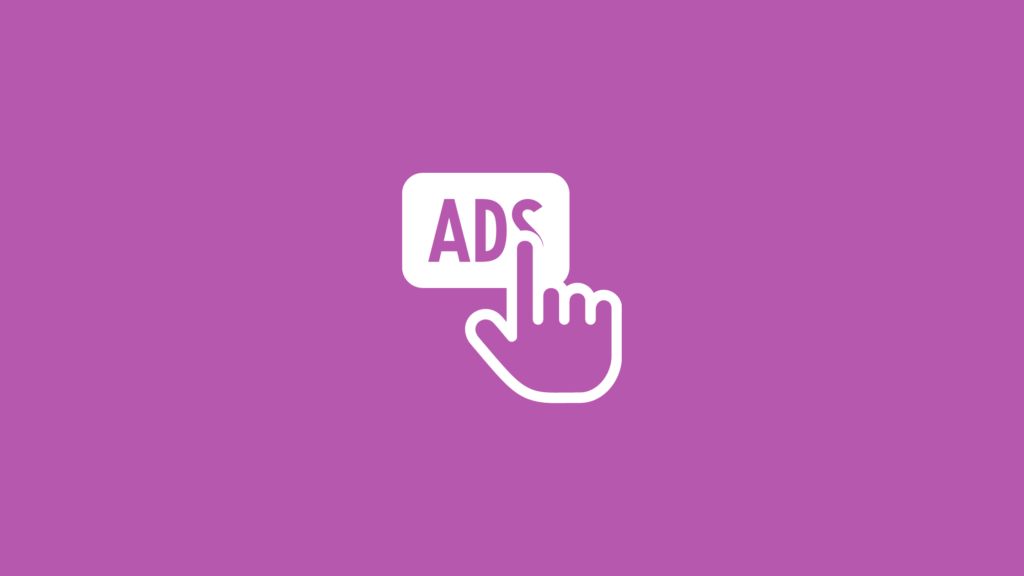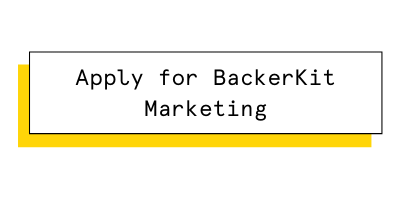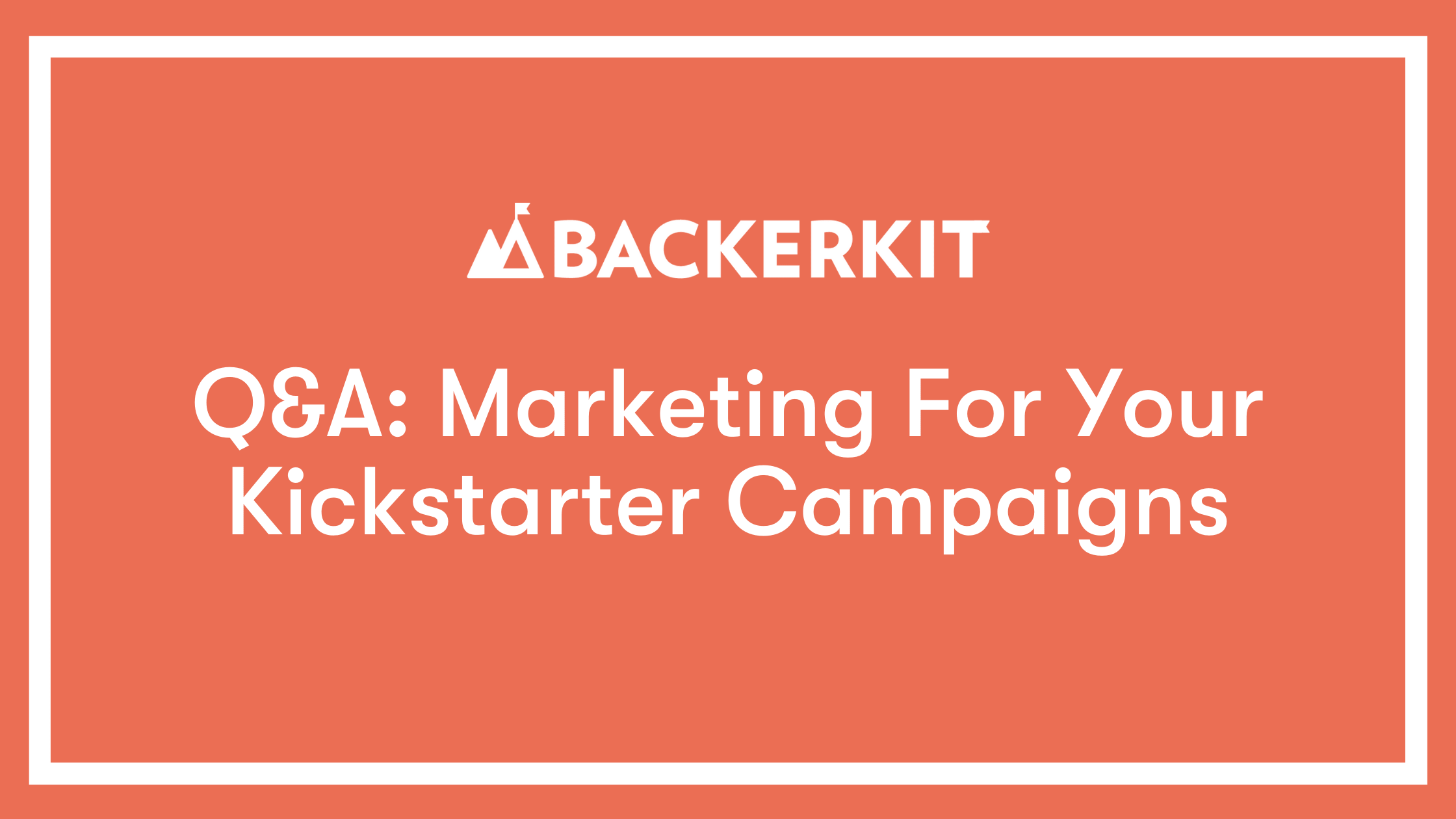When we ask crowdfunding creators which areas of their campaigns are the most challenging, the answer we hear most often is marketing and promotion. Spreading the word about your campaign is essential to your success, so you have to find a marketing strategy that works for you and your budget. We’ve collected a few of your questions on how to begin marketing for your Kickstarter campaigns and answered them here to help you get started.
How do I get my first backers?

Start with friends and family, co-workers, and people you know who are like-minded or believe in your idea. Get them on your email list. At this point, you may only get five people who are interested, or it might be one person, but that’s ok. Then spend time building out your social media channels based on where you like to spend your time. Do you like Instagram the most? Start there. If you like Facebook, go there.
No matter where you start building your community, make sure there’s a funnel to be able to collect email addresses because that will be the most important tool you have as you prepare for launch day. You can use BackerKit Launch to create a landing page to collect these email addresses. You’re going to be messaging the people on this list in the days leading up to your launch to make sure they have a Kickstarter or Indiegogo account set up so they’re primed to back you, educate anyone who may not be familiar with those platforms on how to use them, and encourage people to pledge. All of this will allow you to have a strong start to your campaign.
You want to incentivize email sign-ups. Use language like, “be the first to know when we’re going to launch,” when you’re asking for sign-ups. Maybe give people who sign up a soft discount for when you do launch. Maybe there’s a token that can go along with your product or your game that they can get for being an early adopter and backing in the first 48 hours.
Take some time to research parts of the internet that would be interested in your product and then become a part of those communities. You can’t expect people to just join you without you joining them first. Next, find a few crowdfunding projects that you admire and reach out. Ask the creators questions about what worked for them. Lastly, it’s going to be tempting, but don’t just drop links to your project all over the internet. You have to be a part of the community first.
Can you launch without huge ad spend? What are alternative options?
If you want to hit seven figures, then it’s pretty much inevitable that you are going to spend a lot. But if you’re trying to raise $100,000 or less, it’s absolutely possible to have a successful campaign without spending a lot on ads.
In order to reach your funding goal, you need to bring traffic to your campaign page. Ads do help bring that traffic, but they are by no means the only way. When you’re looking for ad alternatives, you want to make sure that you’re tapping into pre-existing communities.
Hopefully, you will have spent some time building your own community before you launch. These people are already interested in your project, they’re invested in your success, and they’re the group that’s most likely to show up on day one of your campaign and pledge. But you’ll also want to connect with people outside of your community.
Try building relationships with influencers in your project category who have an active, engaged online following. They don’t necessarily even have to have a massive following. If there’s someone in your network who has 1,000 friends on Facebook, and they share your project with that audience, then that’s 1,000 people who could potentially visit your campaign page and pledge.
Think about doing a cross-promotion with another crowdfunding creator. Ask friends to do shout-outs. Send out samples of your product to communities that would be interested in it. Karen Wang from Dispel Dice worked with different publications to get coverage. When you’re marketing for your Kickstarter campaigns, it’s all about finding those communities and audiences that already exist.
Remember that regardless of which strategies you choose when doing marketing for your Kickstarter campaigns, it will take some time to achieve the results you’re looking for. So don’t give up if you aren’t seeing an instant boost in performance. If you’ve tried everything described above for a while and aren’t seeing much progress, assess what you’re doing. Try approaching these strategies from a different angle or scaling up. (For example, instead of just having another creator give you a social media shout-out, scale up and do a livestream together. If you see something is working — even if it isn’t reaching your expectations at the moment — think of ways to build on that success.
Are you an Indiegogo creator? Check out our webinar, Expert Marketing Strategies for Your Indiegogo Campaigns, for practical tips on setting your budget.
Is there merit to running ads on your own instead of hiring an agency if you’re on a shoestring budget?

It depends on where you are in your crowdfunding lifecycle, so if you’re getting ready to launch, it makes sense to run ads on your own. You can experiment to figure out what tweaks you can make to help ad performance. For instance, you can test and learn how you should be framing your value proposition or which marketing assets fully convey what your product is about. That’s something that you should probably be doing on your own. And lots of successful creators do go it alone at first.
However, if you are running Facebook Ads on your own and seeing results that work for your margins and return on ad spend (ROAS) target while your campaign is live, that’s actually a phenomenal signal that you should talk to an agency, and seek out Kickstarter marketing services, and not that you should continue on your own. BackerKit Marketing has audience data and technology that enables us to put your project in front of the most relevant group of people. On your own, you aren’t able to achieve this same level of targeting. But if you are able to achieve exciting results without the audience data, then imagine what’s possible with the audience data.
I’m really uncomfortable with self-promotion. How can I market myself and my project?

Humility is an excellent quality to possess, and right now, you have this cool idea that people will want to know about it. That means you have to do some promotion.
However, you don’t have to immediately dive into the deep end. Start with a Kickstarter marketing plan that you’re comfortable with. You don’t have to jump to do a livestream if you’re more interested in email marketing, or vice versa. You can gradually build up to other marketing techniques as you get more confidence and experience.
Next, look to other creators. That may mean that you go out and get advice on how they’re handling marketing or you look at their social media content, Kickstarter ads, and partnerships, and see what’s working. You don’t have to reinvent the wheel. You’ll learn so much about marketing for your Kickstarter campaigns by connecting with others.
If you’re still finding this challenging, get someone else to build the hype for you. This could be a collaborator, an influencer, a freelance marketer, or an agency. You aren’t expected to be an expert at everything. Part of managing a successful crowdfunding campaign is knowing when to ask for help.
Finally, think about why you decided to launch this campaign in the first place. Is it something you’re passionate about? Will your product help or entertain people? Focusing on that motivation and how you’re actually serving your audience (and not being boastful) can make it easier to push past that initial discomfort.
However you choose to tackle marketing for your Kickstarter campaigns, be authentic. Tell your story and explain why this project is important to you and how it will benefit your backers.
Are you planning to launch a crowdfunding campaign soon and want to get started with BackerKit Marketing? Click below to see if your project is a good fit for the service.
